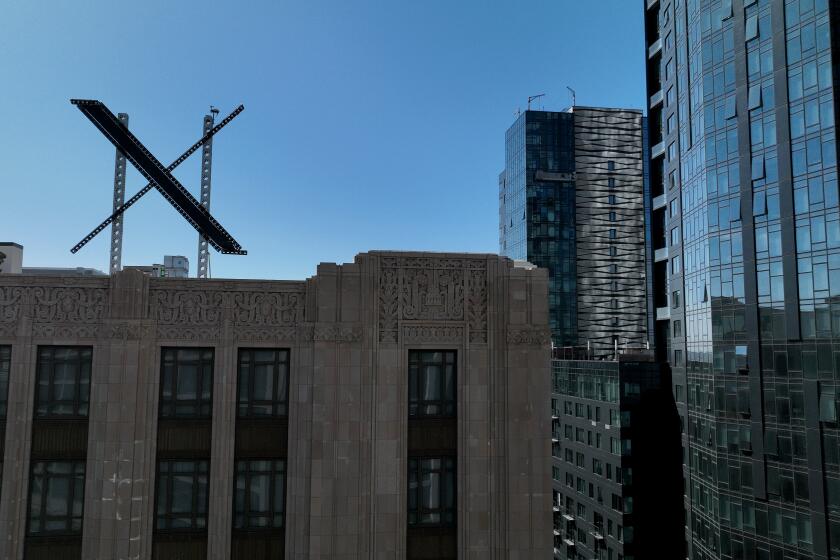Economic Output Off Sharply in Final Quarter : Slump: The 2.1% plunge in the GNP shows weakness in many industries. It also shows the nation is probably in a full-blown recession.
WASHINGTON — The nation’s economic output plunged sharply during the final three months of last year, the government reported Friday--confirming that the country almost certainly is in a full-fledged recession, though possibly not as severe as some analysts had thought.
The Commerce Department’s quarterly report showed that the country’s output of goods and services fell at an annual rate of 2.1% during the quarter, its sharpest decline since the depths of the recession of 1981-82.
Although the drop-off was centered primarily in the auto industry, the weakness was spread through other sectors of the economy--reflecting a pullback by consumers in the face of uncertainty about the economic situation and the mounting crisis in the Persian Gulf.
The fourth-quarter decline was less severe than some analysts had predicted, suggesting that the recession may not last as long as had been feared. Although personal consumption, plunged substantially, business stockpiles narrowed and exports rose again.
Nevertheless, analysts said that the figures were bearish enough to be likely to persuade the Federal Reserve Board to nudge interest rates lower. Fed Chairman Alan Greenspan told Congress earlier this week that the central bank was about to take further steps to ease credit conditions.
The Bush Administration was mildly relieved by the figures. Michael Darby, the Commerce Department’s chief economist, said that the economy’s output probably will shrink again in the January-March quarter but at a less-rapid pace than in the period covered by Friday’s report.
Darby reiterated the Administration’s belief that the economy will begin to grow again during the April-June quarter. But he cautioned that the outlook depends on what happens in the Persian Gulf and “how soon business and consumer confidence can be restored.”
Private economists were somewhat more cautious. Roger Brinner, chief economist for DRI/McGraw Hill, a Lexington, Mass., economic forecasting firm, said the fourth-quarter figures show that “we’re not in as great trouble as the doomsayers have been saying.”
But Allen Sinai, economist for the First Boston Co., noted that “there are signs the contraction was compressed and that could limit (the recession’s) length.”
Giulio Martini, an economist at Sanford C. Bernstein & Co. in New York, agreed. “We had an actual inventory liquidation and that’s unusual, except in the later stages of a recession,” Martini said. “This suggests that additional production cuts . . . should be small.”
The fall in the economy’s output was the steepest since the third quarter of 1982--the depth of the last recession, when the “real” gross national product, as the figure is called, fell at an annual rate of 3.2%.
Friday’s figures showed that for all of 1990, the economy grew by a scant 0.9%, its weakest annual performance since 1982, when output plunged by 2.5% for the year. Before adjustment for inflation, output was up at a 0.3% annual rate during the quarter to $4.148 trillion.
The slump was concentrated primarily in Detroit, where auto makers, faced with extremely wary consumers, cut output sharply to avoid building up huge stocks of unsold cars. Some analysts had expected the overall drop to reach a 3.4% annual rate.
According to the Commerce Department, the fourth-quarter performance was almost unaffected by the U.S. troop deployment in the gulf. Although the military stepped up some purchases at home, it also bought some goods overseas, which counted negatively as imports.
Even so, the report documented earlier signs of economic weakening. Personal consumption fell sharply, declining at an annual rate of 3.1%, or $21 billion. And housing expenditures plunged at an annual rate of 15.4%, or $7.1 billion.
Jerry L. Jordan, economist for First Interstate Bancorp in Los Angeles, said that analysts could take heart from the fact that business inventories had been drawn down.
“Usually what happens is that businesses fail to see trouble coming, so production keeps rolling along while sales decline and then jobs fall off,” he said. “This time, perhaps because of the Middle East fears, they didn’t hesitate.
“So there’s no need to expect the other shoe to drop in the next quarter.”
And DRI’s Brinner said that the continuing boom in exports had largely offset the dampening effect of the crisis in the gulf.
“The invasion of Kuwait thoroughly intimidated consumers, but world markets are growing and the United States is getting a bigger share of those markets,” he said.
Even the fourth-quarter price index--considered the broadest measure of inflation--appeared to be mildly encouraging. The figures showed inflation at an annual rate of only 4.1%--well below the 6% pace at which consumer prices have risen. The third-quarter figure was 4.2%.
For all of 1990, the inflation index rose 4.5%, the same as in 1989, the Commerce Department reported.
The last recession lasted 16 months, from July, 1981, to November, 1982.
Aside from the second quarter of 1986, when the GNP fell at a 1.8% annual rate, the economy expanded without interruption until the final quarter last year. It was the longest U.S. peacetime expansion on record.
More to Read
Inside the business of entertainment
The Wide Shot brings you news, analysis and insights on everything from streaming wars to production — and what it all means for the future.
You may occasionally receive promotional content from the Los Angeles Times.










